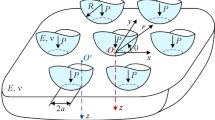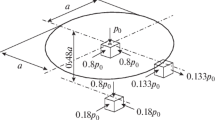Abstract
The interaction between a machined surface and an abrasive material was analyzed in the framework of concepts of electron exchange between their atoms. Using as examples several combinations of two solids in contact, it was shown that the extent of interaction between them is lowest when the electron exchange does not lead to the formation of energetically stable states by the interacting atoms and when the majority of nonlocalized electrons remains in a free state and forms a specific “electron lubricant” which prevents interaction. The results of this analysis were verified on the example of the selection of abrasive materials for grinding titanium alloys.
Similar content being viewed by others
References
N. F. Lashko and S. V. Lashko-Avanesyan, Welding Metallurgy [in Russian], Mashgiz, Moscow, 270, 1954.
N. F. Kazakov, Vacuum Diffusion Welding of Metals, Alloys, and Nonmetallic Materials [in Russian], Izd. TIMMP, Moscow, 1965.
B. V. Deryagin, What is Friction ? [in Russian], Izd. AN SSSR, Moscow, 1952,
N. N. Zorev, Vestnik mashinostroeniya, no. 2, 1965.
A. Ya. Artamonov and V. I. Kononenko, Poroshkovaya metallurgiya, no. 10, 1966.
G. V. Bokuchava, collection: High-Productivity Grinding [in Russian], Izd. AN SSSR, Moscow, 1962,
A. Ya. Artamonov, A. I. Bezykornov, and A. N. Ivanov, Poroshkovaya metallurgiya, no. 9, 1966.
A. Ya. Artamonov and E. T. Mamykin, FKhMM [Soviet Materials Science], no. 1, 1966.
M. I. Korsunskii and Ya. E. Genkin, DAN SSSR,142, 1276, 1962.
M. I. Korsunskii and Ya. E. Genkin, Izv. AN SSSR, Fizika,28, 832, 1964.
M. I. Korsunskii and Ya. E. Genkin, Neorganicheskie materialy, no. 10, 1965.
A. Z. Men'shikov and S. A. Nemnonov, FMM,19, 57, 1965.
I. B. Bersuker and A. V. Ablov, Chemical Bonds in Chemical Complexes [in Russian], Izd. AN MoldSSR, Kishinev, 1962.
L. Orgel, Introduction to the Chemistry of Transition Metals [Russian translation], Izd. Mir, Moscow, 1964.
G. V. Samsonov, UKhZh, no. 12, 1965.
D. M. Yost, H. Russell, and C. S. Garner, Rare-Earth Metals and Their Compounds [Russian translation], IL, 1949.
O. A. Bulanin, Oxidation of Boron Carbide [in Russian], Byulleten TsNILASh, no. 6,53, 1937.
L. Goes, Industrial and Engineering Chemistry,47, no. 12, 2493, 1955.
H. W. Wagner, Grits and Grinds,42, no. 8, 1951.
L. Tarasow, The Machinist,97, no. 9, 335, 1953.
V. D. Sil'vestrov, Ways of Increasing the Durability and Reducing the Wear of Grinding Wheels for Heat-Resistant Alloys [in Russian], MDNTP im. Dzerzhinskogo, 1958.
T. N. Loladze, Wear of Cutting Tools [in Russian], Mashgiz, 1958,
V. D. Sil'vestrov and V. A. Kubrak, Specific Features of Grinding in Titanium Alloys [in Russian], VINIT, tema 10, no. M-57-11/3, 1957.
V. D. Sil'vestrov and V. A. Kubrak, Aviatsionnaya promyshlennost, no. 10, 1956.
Author information
Authors and Affiliations
Rights and permissions
About this article
Cite this article
Samsonov, G.V., Artamonov, A.Y. & Idzon, M.F. Interaction of two solids in contact. Mater Sci 4, 311–315 (1971). https://doi.org/10.1007/BF00722621
Issue Date:
DOI: https://doi.org/10.1007/BF00722621




